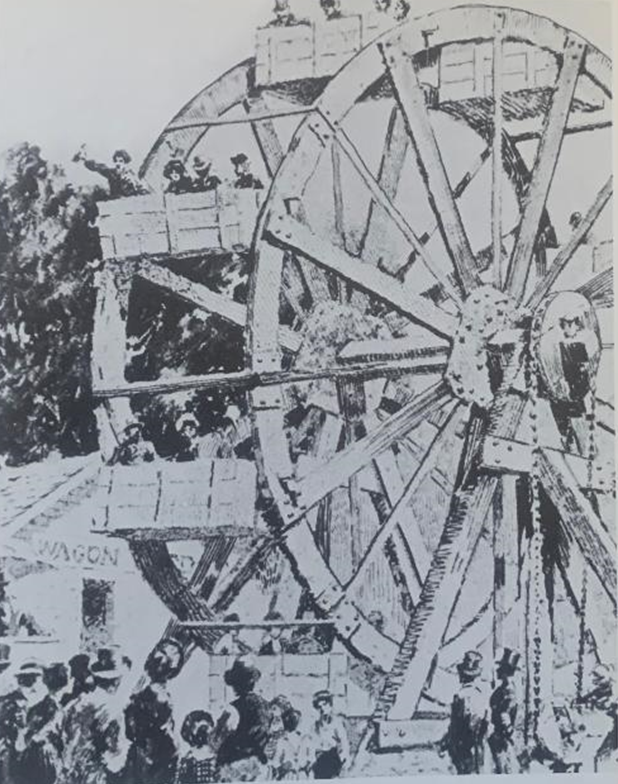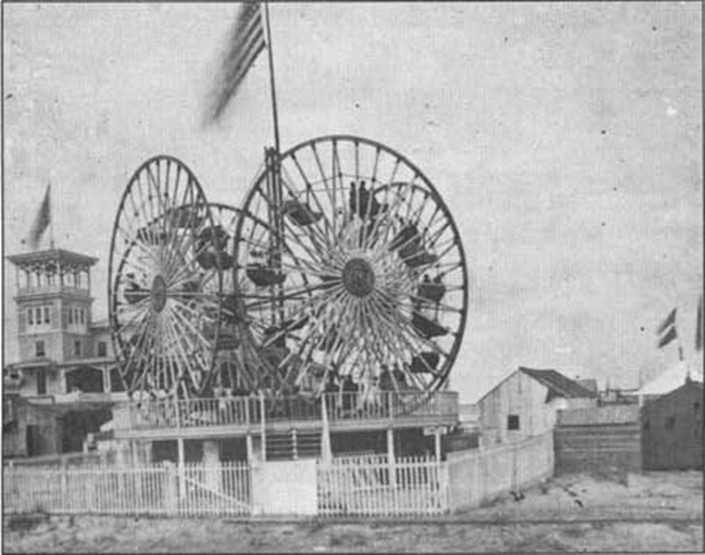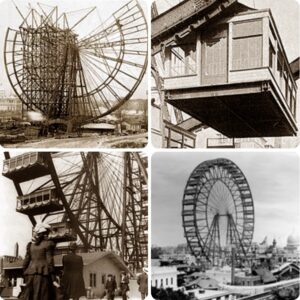by Ron Becker, Class of 2019
One of our sharp-eyed docents saw a detail in a painting featured in the recent Van Gogh exhibit at the Art Institute that prompted her to ask, “Wasn’t the Ferris wheel invented in Chicago?” Notice the detail at the left in the picture.


The answer is George Washington Gale Ferris, Jr. did indeed invent, build, and operate a giant wheel ride for the Columbian Exposition in Chicago in 1893. Originally known as the Chicago Wheel, it has since been called the Ferris Wheel (with a capital W). Ferris wheel (with a small w) has entered the American lexicon as a generic term for large vertical wheel rides. Vertical wheel rides may date back to at least the 17th century. They were generally small, wooden, manually operated rides for just a few passengers. They were called pleasure wheels, up-and-downs, or vertical swings among other names. As they grew larger, they were sometimes called observation wheels.

A Frenchman, Antonio Manguino, introduced the idea to America in 1848, when he constructed a wooden pleasure wheel to attract visitors to his fair in Walton Spring, Georgia. Passengers sat in packing crates, and power was supplied by two powerful men.

Americans being American, there was felt a need to make wheels larger and motorized. An early example was a design by Issac Forrester that he called the Epicycloidal Diversion. It consisted of four vertical wheels at right angles to each other connected to a central shaft, all sitting on a raised platform. When the shaft rotated the wheels in a horizontal direction, the motion caused them to rotate vertically. The wheel was exhibited at Coney Island in 1872.

Other early examples were the 50-foot wooden wheels built by William Somers in 1892. Somers called his rides ‘Roundabouts’. One was erected at Coney Island and was ridden by George Ferris while on vacation. William Sommers was granted the first US patent for a vertical wheel ride.

George Ferris responded to Daniel Burnham’s challenge to American engineers to build something that would show the ingenuity and prowess of American engineering and that would out-Eiffel the Eiffel Tower. Ferris certainly accomplished that. Ferris was considered an expert in steel structures. He was in Chicago with a contract to inspect the steel structures of the World’s Fair buildings. He was educated at the Rensselaer Polytechnic Institute where one of his professors was John Alexander Low Waddell. A few years later in Chicago, Waddell would make a name for himself as the engineer for the elevated railroad loop structure.

The Ferris Wheel had a 250-foot diameter set on 140-foot towers for a total height of 264 feet. Each of the 36 coaches could hold 60 riders for a total capacity of 2,160 people. Nearly 1.5 million guests rode the wheel during the Exposition’s run.
The Ferris Wheel remained on the Midway Plaisance without any additional riders until the spring of 1894 when it was dismantled and stored. It was erected again as part of an amusement park project at the edge of Lincoln Park near Fullerton and Clark in September 1895. One of the investors in this project was Charles T. Yerkes who expected patrons to ride his streetcars to the park. However, neighborhood opposition and the failure to obtain a liquor license doomed this venture. At the end of the 1903 season the Ferris Wheel was again dismantled, loaded onto 175 railcars, and shipped to St. Louis. There it became a major attraction for the 1904 Louisiana Purchase Centennial Exposition. After the fair it remained on the fair grounds until May 11, 1906, when a controlled dynamite explosion reduced it to a pile of rubble.


Things happen when bridge engineers ride Ferris wheels. William E. Sullivan. a bridge engineer from Roodhouse, Illinois, rode the Ferris Wheel several times and made detailed sketches. His goal was not to top the Ferris Wheel but to produce a portable model that could be shipped around the country. He built his first wheel in 1900, and in 1906 incorporated his company, Eli Bridge Company in Jacksonville, to build Ferris wheels. Eli Bridge is still in operation and is the world’s largest manufacturer of Ferris wheels. If you have ridden a Ferris wheel at an amusement park, carnival or county fair, it is likely you have ridden on an Eli wheel.

Ferris wheels have come back to Chicago. As part of the 1995 renovation of Navy Pier as a tourist destination a 147-foot wheel was installed. In 2016 that wheel was replaced by a 196-foot wheel as part of the centennial celebration of Navy Pier. This wheel has been dubbed The Centennial Wheel.


Enjoy your Ride!
_____________________________________________________________________________________

CLICK HERE for more stories on The Bridge.






Good article. I learned a few things I didn’t know.
Absolutely fascinating! Thanks
Thank you Ron that was really interesting!
Thanks Ron, what a fun and interesting article. And when you give Mary Jo new information, you have dug deep into the topic. Your curiosity is keeping us docents in the know on a variety of topics. Thanks so much.
Fascinating. Thanks, Ron!
Thanks, Ron, for clarifying this. I thought ours was the first and I now stand corrected!
What a terrific article. So much good information. Thank you, Ron.
This was wonderful Ron, Thank you for your research and as always, the fun photos!
Ron, You made my head spin round and round! Fun history lesson. Thanks, Suzy Ruder